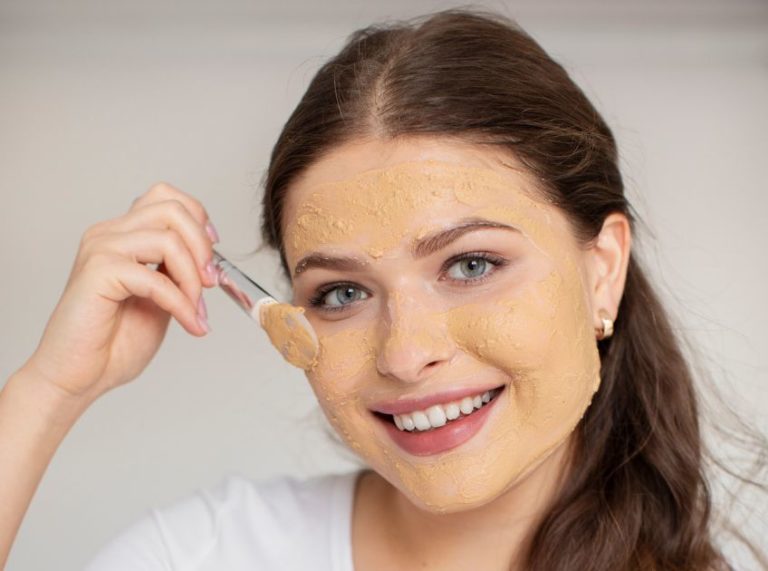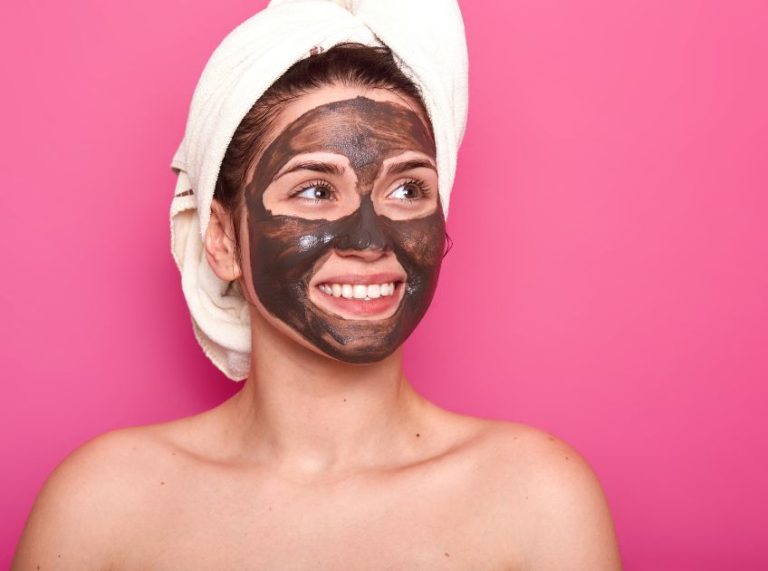
Important: This article is for informational purposes only. Please read our full disclaimer for more details.
Can glycolic acid be used with retinol? This is a ubiquitous question that confuses many people. According to dermatologists, they can both be used on the skin as skincare ingredients. However, certain things need to be kept in mind while using them.
The foremost among them is avoiding mixing glycolic acid with retinol. During initial days, use them at different times of the day or week. Slowly, you can reduce the duration between their usages.
To understand how to use glycolic acid with retinol, you must first understand the mechanism of glycolic acid and retinol functioning and the science behind them.
What is Glycolic Acid?
Glycolic acid is an alpha hydroxy acid that is found in sugar cane (1). It is a chemical exfoliator that removes dead skin and even out skin tone by dissolving bonds between skin cells. This property of glycolic acid refreshes the skin and makes it an ideal ingredient for cleansers, masks, peels, and serums.
Glycolic acid also supports other treatment ingredients like phytic acid to penetrate the skin better, combat hyperpigmentation, and provide instant shine on the user’s face.
Hence, glycolic acid is an acid and according to the regulations, it cannot be found more than 30 percent in over-the-counter products. However, dermatologists prefer using higher strength glycolic acid for chemical peeling.
There are some guidelines to be kept in mind while using glycolic acid products:
- Face wash having glycolic acid can be used once daily.
- An active serum constituting glycolic acid may be used once or twice a week. Depending upon skin toleration, it can, however, be increased to three times per week.
- A glycolic acid peel and mask can be used 2-3 times per week.
What is Retinol?
Retinol is a topical vitamin A that reduces fine lines, skin discoloration and clogged pores (2). It helps to initiate collagen production and cell turnover. Since it is a type of retinoid which is not as strong as other retinoids, it makes it a readily available option that does not need a prescription to be purchased.
Retinol functions primarily by stimulating collagen production and other related compounds essential for healthy glowing skin (3). It treats acne by unclogging pores and gives an improved skin turnout effect. Retinol also effectively fights skin aging by reducing wrinkles and fine lines. However, if overused, it can dry the skin. Hence, it is always advised to use an optimum amount for skin type.
Retinol can be purchased over the counter as a cream or serum. The ideal way to use retinol is to apply it on washed skin once or twice a week before bed, followed by a moisturizer. You can slowly increase the application once your skin has endured it. As retinol makes skin sensitive to UV rays, ensure that you apply sunscreen every day.
How to Use Retinol and Glycolic Acid Together?
Initially, people had the false beliefs in choosing either one, glycolic acid or retinol, for their skincare routine. This came from the unsure credence that glycolic acid with retinol interferes retinol’s ability to act on the skin.
However, recent studies have suggested that glycolic acid with retinol can be safely used if used under guidance and advised instructions (4). In fact, this combination might give better results in treating acne and acne scar treatment.
Both glycolic acid and retinol have the property of causing skin irritation. Hence, dermatologists suggest using both of them during the skincare routine but alternatively. The general tips to follow while using glycolic acid and retinol safely to avoid irritation caused by these potent agents are as follows:
- Make a schedule of glycolic acid and retinol usage. Keep in mind to have separate days and gaps between their usages.
- Start using glycolic acid once a week to check how your skin responds to it. Increase the number of days to a few times weekly- slowly using it every alternate day. Remember that your skin might need a considerable time to get used to it.
- Once your skin gets accustomed to glycolic acid, start with retinol. Use it only once a week to observe how your skin reacts to it.
- Slowly increase retinol use, leading to its usage alternating with glycolic acid.
- Once your skin gets wholly acclimatized and you do not notice any irritation or dryness, try using one in the morning and another in the evening.
- Do not apply active ingredients like Vitamin C and Alpha hydroxy acid immediately after glycolic acid. This can cause severe irritation and dryness.
- Retinol can make your skin sensitive to the sun and expose you to ultraviolet radiation. Hence, remember to layer your skin with sunscreen.
- Do not skip applying moisturizer, as your skin might be prone to drying because of glycolic acid and retinol.
- Pregnant and breastfeeding women should avoid retinol use. Use of glycolic acid should also be done after consultation with a dermatologist.
How To Choose Between Glycolic Acid And Retinol
If using glycolic acid with retinol creates skin issues, you need to choose one of the ingredients and stick only to it in your skincare routine. This will largely depend on your skin type. Though using glycolic acid with retinol at the same time works for many people, some skin type might have risks when used together.
Check what exactly you want to achieve and which issue needs the most attention immediately, and then decide the ingredients accordingly.
Use Retinol If Your Primary Concern Is To Treat Aging Skin
Retinol revitalizes skin cells by reducing the appearance of fine lines and wrinkles (5). It doesn’t clear off the dead cells but makes the existing cells healthier. Retinol also reduces the effect of sun damage and makes skin supple. It also unclogs the pores that can cause acne and boosts skin health.
Use Glycolic Acid If Your Skin Is Sensitive
Glycolic acid causes less irritation than retinol as it is less drying. It works as an exfoliate and can remove dead skin cells and clear out excess oil from clogged pores. Glycolic acid works better on oily skin facing discoloration or texture-related issues.
Side Effects Of Using Glycolic Acid And Retinol Together
Both glycolic acid and retinol are potent ingredients that must be used properly and precisely. Excessive use of glycolic acid and retinol can negatively affect the skin and create further issues.
Though considered safe, some possible side effects that could arise are as follows:
- Glycolic acid with retinol can increase sensitivity to sunburn and skin damage. Hence, they must be used along with sunscreen to avoid the harmful effects of ultraviolet radiation.
- Sometimes, Glycolic acid and retinol application might lead to skin peeling, flaking, and itchiness. This is mostly temporary, and the skin returns to normal once it gets used to these products.
- In extreme cases, it might lead to redness and fluffiness of the skin. In such cases, you must immediately stop using and consult a dermatologist.
- Dark skin people may find hyperpigmentation on their skin because of glycolic acid and retinol use.
It can be overwhelming to decide whether to use glycolic acid with retinol or separately, but once you identify your skin type, you choose the product accordingly. Keep the dose lower at the initial phase and consult a dermatologist whenever needed.
You Might Also Like:
- How Long Does It Take for Retinol to Work?
- Retinol vs Retinal: What’s the Difference?
- How to Use Retinol and Tretinoin Together? and Benefits
- Can You Use Lactic Acid And Niacinamide Together?
- How to Use Hyaluronic Acid and Retinol Together? Benefits & Side Effects
- How to Use Retinol with Benzoyl Peroxide Together?
- Can I Use Aha and Bha Together? Benefits and How to Use It
- Can I Use Lactic Acid and Aha Together?
- Can I Use Copper Peptides with Retinol Together?
- Pure Biology Retinol Moisturizer Cream Review
- BLOOMMY Collagen & Retinol Cream
- How to Use Retinol and Alpha Arbutin Together
- Bakuchiol Vs Retinol: Which Is Better for Your Skin?
- Can You Mix Bakuchiol and Vitamin C Together
- Azelaic vs Salicylic Acid: Which One Should You Choose?
- How to Use Niacinamide and Ceramides Together?
- Can I Use Salicylic Acid with Hyaluronic Acid Together?
- How to Use Licorice Root for Skin?
- How to Use Hyaluronic Acid and Vitamin C Serum
- How to Use Lactic Acid and Retinol Together
- Unlock Radiant Skin: Discover the Magic of Numbuzin No.3 Skin Softening Serum
- How To Get Rid of Open Pores Naturally at Home?
- Quadruple Hyaluronic Acid Serum 5 Review
- 7 Best Products For Large Pores And Oily Skin
- 7 Best Creams For Skin Graft
- 7 Best Toning Creams For Black Skin Without Hydroquinone
- 6 Simple Homemade Natural Eye Creams for Dark Circles


















